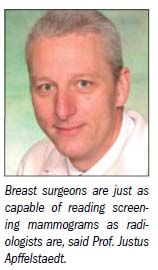Breast surgeons to tackle screening mammography
Radiologists too often are either unwilling or unable to interpret screening mammography exams, so breast surgeons should learn the specialty and fill in when needed, an international speaker told a group of breast surgeons recently.
Radiologists too often are either unwilling or unable to interpret screening mammography exams, so breast surgeons should learn the specialty and fill in when needed, an international speaker told a group of breast surgeons recently. Breast surgeons can read screening mammograms just as well as radiologists, so there's no reason they shouldn't become involved, said Prof. Justus Apffelstaedt at the American Society of Breast Surgeons conference.
This solution could apply particularly in rural areas where qualified mammographers are in short supply or unavailable, he said.
Apffelstaedt was among the featured speakers at the conference, which was held in Las Vegas. He presented data supporting his assertions from a study done at a comprehensive breast care center in his native Cape Town, South Africa.

The study covered 16,164 breast investigations, 75% of them for screening. The surgeons diagnosed 87 patients with malignancy and performed 221 biopsies. The recall rate ranged from 4.2% to 5.6% depending on the age of the women. Those recall rates are comparable to what is found in screening programs in the U.K. and Australia, Apffelstaedt said.
While some radiologists may gawk at such a low recall rate, the surgeons from this study read more than 4000 mammograms annually, and the recall rates fall within the range expected in well-run organized screening programs, he said.
First assessment was by a radiation technologist and a consensus was established after a second reading by experienced breast surgeons with extensive training in mammography, he said. Besides their training, breast surgeons have the experience of reading mammograms before they perform surgery.
The problem with saying most surgeons see mammograms already is that they see them only after the mammograms are read by radiologists, said Dr. Kathy Schilling, medical director of imaging and intervention at Boca Raton Community Hospital's Center for Breast Care in Florida. The vast majority of surgeons never see the full range of mammograms; they don't sort out the normal from the abnormal, she said.
“To think someone with only on-the-job training can teach themselves the intricacies of breast imaging is a little bit shocking, particularly when one of the readers is a technologist,” Schilling said.
But a surgeon has as much a right to read screening mammograms as a radiologist does, said Dr. Phil Evans, president of the Society of Breast Imaging.
“In order to interpret mammography in the U.S., a physician must meet FDA Mammography Quality Standards Act requirements,” he said. “So any physician, surgeon or otherwise, who wishes to complete the training can be qualified to read mammography.”
As a practical matter, almost all physicians interpreting mammography in the U.S. are diagnostic radiologists due to the extensive training needed for interpretation, the technical aspects of mammography, quality assurance, quality control, and CME requirements, Evans said.
The reality is that U.S. surgeons don't have the time to get themselves credentialed to interpret mammograms, said Dr. Ellen Mendelson, a professor and director of breast imaging at Northwestern University. If they do, they probably shouldn't be doing surgery.

In Cape Town, the practice of surgeons reading screening mammograms was born out of necessity because there weren't enough radiologists available who were reading mammography at a high level of quality, Apffelstaedt said.
“I don't think, in general, you will find an awful lot of breast surgeons interested in reading mammography. But I think if you're looking at sites where there's a scarcity of radiologists, why should breast surgeons not become involved in it?” he said.
Even if Apffelstaedt is getting good results, the approach won't necessarily work in the U.S., Mendelson said.
“As a general recommendation and as a policy for the future, that's not the way we are developing multimodality breast imaging in the U.S.,” she said. “It's not the best way to provide patient care.”
AI-Initiated Recalls After Screening Mammography Demonstrate Higher PPV for Breast Cancer
March 18th 2025While recalls initiated by one of two reviewing radiologists after screening mammography were nearly 10 percent higher than recalls initiated by an AI software, the AI-initiated recalls had an 85 percent higher positive predictive value for breast cancer, according to a new study.
ECR Mammography Study: Pre-Op CEM Detects 34 Percent More Multifocal Masses than Mammography
February 28th 2025In addition to contrast-enhanced mammography (CEM) demonstrating over a 90 percent detection rate for multifocal masses, researchers found that no significant difference between histological measurements and CEM, according to study findings presented at the European Congress of Radiology.
Study: Mammography AI Leads to 29 Percent Increase in Breast Cancer Detection
February 5th 2025Use of the mammography AI software had a nearly equivalent false positive rate as unassisted radiologist interpretation and resulted in a 44 percent reduction in screen reading workload, according to findings from a randomized controlled trial involving over 105,000 women.